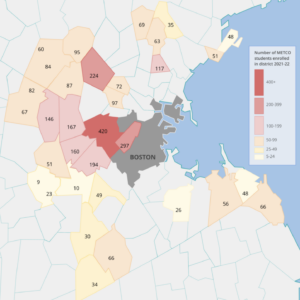 The state of Massachusetts is still highly segregated despite the removal of segregation laws many years ago. Take Boston for example: according to census data, “two-thirds of Boston’s Black residents still live in” Dorchester, Roxbury, or Mattapan. The greater Boston area consists of suburbs that “are at least 90 percent white.” In a state that is so segregated, othering is very common. Many people are quick to designate the black community as “other,” avoiding restaurants, shops, and schools. When considering these Black neighborhoods, white residents of Boston often group them together as the “others,” perpetuating segregation in the 21st century.
The state of Massachusetts is still highly segregated despite the removal of segregation laws many years ago. Take Boston for example: according to census data, “two-thirds of Boston’s Black residents still live in” Dorchester, Roxbury, or Mattapan. The greater Boston area consists of suburbs that “are at least 90 percent white.” In a state that is so segregated, othering is very common. Many people are quick to designate the black community as “other,” avoiding restaurants, shops, and schools. When considering these Black neighborhoods, white residents of Boston often group them together as the “others,” perpetuating segregation in the 21st century.
Although othering happens frequently in Massachusetts, there have been some attempts to take this issue head-on. One example of this effort exists in my home town of Natick, MA. The Natick Public School district partnered with a program called The Metropolitan Council for Educational Opportunity (METCO). Through this program, students living in Boston attend school in Natick. METCO is a direct response to the segregation and othering that still occurs in Massachusetts. It is an attempt to desegregate schools and provide resources to students living in Boston. The public school districts in Boston lack the resources that many of the suburban towns, like Natick, have. However, this program is highly selective and most Boston students stay in the Boston Public School district.
This attempt to integrate Black students into primarily white suburban schools isn’t always effective in eliminating the concept of “others.” The black students that are part of the METCO program still have disadvantages within the Natick school district that cause them to be “othered” by both their teachers and their peers. The METCO students take the bus to and from Natick every morning and afternoon during rush hour. Due to this long commute, they are unable to participate in before-school and after-school activities such as sports or clubs. This causes many white students in Natick schools to consider the METCO students as “others” because they aren’t fully engaged in the school community. White students, including my classmates, have grouped the METCO students as a separate entity, not part of the sports teams or school community. Additionally, there is a divide between METCO students and Natick students, as they are typically in different friend groups. Many Natick students feel that they have little in common with the METCO students. Natick students are from the suburbs, Boston students are from the city. Rather than taking the time to eliminate the assumptions that lead us to “other” the METCO students, most Natick students continue to dwell on the differences.
Othering is something that is important to consider when studying the Tigris Valley region. Similar to Massachusetts, the Tigris Valley region has different religions and cultures that often exist in separate parts of the region. Othering occurs when we look at the way these groups interact with each other. It can help us understand how groups are treated, and how conflict has arisen.
Additionally, othering is important to consider from the perspective of an American student studying the Tigris Valley Region. To other people means to categorize them and make assumptions about them based on little to no evidence. It can cause us to overlook the nuances of individuals, by looking at them as one large group. If we want to fully understand how Tigris Valley states are domestically, we must look at their people as individuals rather than a group.



Leave a Reply